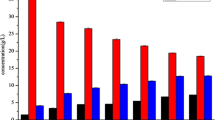Abstract
Increased attention has been given to whole grain and plant-based foods due to health concerns. Sweet fermented oats (SFOs) are such traditional fermented food from China. However, reports on their microbiota and relations with the nutrients and flavor were scarcely few, hindering their wider application. The comprehensive microbial composition, metabolic compounds and their correlations of representative SFOs from northwestern China were firstly investigated. Firmicutes predominated the microbial communities, followed by Proteobacteria. Weissella, Bacillus and Lactobacillus were dominant bacterial genera, biomarkers and core bacteria as well. GC–MS (Gas Chromatography–Mass Spectrometer) identified the metabolic compounds, among which the categories fatty acids and carboxylic acids most abundant. Eighteen chemicals showed significant differences among the five SFOs, including ethyl octanoate, neryl acetate, l-sorbose, diglycerol, cellotetraose etc. Fatty acids, carboxylic acids, amino acids, peptides, oligosaccharides, and monosaccharides were the key substances responsible for the unique flavor and rich nutrients in SFOs. The core bacteria were closely related to chemical acids, esters, flavone and alcohol. Pediococcus showed a negative correlation with 2,3-butanediol. SFOs were made in the laboratory with the core bacterial strains, obtaining a high abundance of nutrient chemicals and sensory evaluation value. The research provided a foundation for the improvement, further application and industrialization of SFOs.






Similar content being viewed by others
References
Angelov A, Yaneva-Marinova T, Gotcheva V (2018) Oats as a matrix of choice for developing fermented functional beverages. J Food Sci Tech 55(7):2351–2360. https://doi.org/10.1007/s13197-018-3186-y
Baldwin EA, Scott JW, Einstein MA et al (1998) Relationship between sensory and instrumental analysis for tomato flavor. J Am Soc Hortic Sci 123(5):906–915
Bulgarelli D, Garrido-Oter R, Münch PC et al (2015) Structure and function of the bacterial root microbiota in wild and domesticated barley. Cell host microbe 17(3):392–403. https://doi.org/10.1016/j.chom.2015.01.011
Caporaso JG, Kuczynski J, Stombaugh J, Bittinger K, Bushman FD, Costello EK (2010) QIIME allows analysis of high-throughput community sequencing data. Nat Methods 7:335–336. https://doi.org/10.1038/nmeth.f.303
Chen S, Zhou Y, Chen Y, Gu J (2018) Fastp: an ultra-fast all-in-one FASTQ preprocessor. Bioinformatics 34(17):i884–i890. https://doi.org/10.1093/bioinformatics/bty560
Cui Y, Qu X, Li H et al (2012) Isolation of halophilic lactic acid bacteria from traditional chinese fermented soybean paste and assessment of the isolates for industrial potential. Eur Food Res Technol 234(5):797–806
Delgado-Baquerizo M, Oliverio AM, Brewer TE et al (2018) A global atlas of the dominant bacteria found in soil. Science 359:320–325. https://doi.org/10.1126/science.aap9516
Edgar RC (2013) UPARSE: highly accurate OTU sequences from microbial amplicon reads. Nat Methods 10(10):996–998. https://doi.org/10.1038/nmeth.2604
El Baidouri F, Venditti C, Humphries S (2017) Independent evolution of shape and motility allows evolutionary flexibility in Firmicutes bacteria. Nat Ecol Evol 1:0009. https://doi.org/10.1038/s41559-016-0009
Food and Agriculture Organization (FAO) (2020) FAO statistical programme of work 2020–2021. FAO, Rome, Italy
Galle S, Schwab C, Arendt E, Gänzle E (2010) Exopolysaccharide-forming Weissella strains as starter cultures for sorghum and wheat sourdoughs. J Agric Food Chem 58(9):5834–5841. https://doi.org/10.1021/jf1002683
Guan QQ, Zheng W, Huang T et al (2019) Comparison of microbial communities and physiochemical characteristics of two traditionally fermented vegetables. Food Res Int 128:108755
Gustaw K, Niedwied I, Rachwa K, Polak-Berecka M (2021) New insight into bacterial interaction with the matrix of plant-based fermented foods. Foods 10(7):1603. https://doi.org/10.3390/foods10071603
Hu N, Lei M, Zhao X, Zhang Z, Wang S (2020) Analysis of the microbial diversity and characteristics of fermented blueberry beverages from different regions. Foods 9(11):1656. https://doi.org/10.3390/foods9111656
Konings WN, Kok J, Kuipers OP, Poolman B (2000) Lactic acid bacteria: the bugs of the new millennium. Curr Opin Microbiol 3(03):276–282. https://doi.org/10.1016/S1369-5274(00)00089-8
Langille MGI, Zaneveld J, Caporaso JG et al (2013) Predictive functional profiling of microbial communities using 16S rRNA marker gene sequences. Nat Biotechnol 31:1–10
Ling HZ, Shi H, Chen XC, Cheng KK (2022) Detection of the microbial diversity and flavour components of northeastern chinese soybean paste during storage. Food Chem 374:131686. https://doi.org/10.1016/j.foodchem.2021.131686
Lopes ACA, Andrade RP, Oliveira LCC et al (2020) Production and characterization of a new distillate obtained from fermentation of wet processing coffee by-products. J Food Sci Tech 57:4481–4491. https://doi.org/10.1007/s13197-020-04485-4
Luana N, Rossana C, Curiel JA, Kaisa P, Marco G, Rizzello CG (2014) Manufacture and characterization of a yogurt-like beverage made with oat flakes fermented by selected lactic acid bacteria. Int J Food Microbiol 185:17–26. https://doi.org/10.1016/j.ijfoodmicro.2014.05.004
Magoč T, Salzberg SL (2011) FLASH: fast length adjustment of short reads to improve genome assemblies. Bioinformatics 27(21):2957–2963. https://doi.org/10.1093/bioinformatics/btr507
Murillo-Roos M, Uribe-Lorío L, Fuentes-Schweizer P et al (2022) Biogas production and microbial communities of mesophilic and thermophilic anaerobic co-digestion of animal manures and food wastes in costa rica. Energies 15:3252. https://doi.org/10.3390/en15093252
Nakagawa M, Kawano Y, Akasaka Y (2003) Resistance of Bacillus endospores to extreme terrestrial and extraterrestrial environments. Digest Endosc 16(1):84–87. https://doi.org/10.1128/MMBR.64.3.548-572.2000
Rankine BC (2010) Factors influencing the pyruvic acid content of wines. J Sci Food Agr 16(7):394–398
Ren F, Yan DH, Liu YC, Wang C, Guo C (2021) Bacterial and fungal communities of traditional fermented chinese soybean paste (doujiang) and their properties. Food Sci Nutr 9(10):5457–5466. https://doi.org/10.1002/fsn3.2505
Rul F, Zagorec M, Champomier-Vergès MC (2013) Lactic acid bacteria in fermented foods. In: Toldrá F, Nollet L (eds) Proteomics in foods. Food microbiology and food safety, vol 2. Springer, Boston, MA, pp 261–283. https://doi.org/10.1007/978-1-4614-5626-1_15
Segata N, Izard J, Waldron L et al (2011) Metagenomic biomarker discovery and explanation. Genome Biol 12:R60. https://doi.org/10.1186/gb-2011-12-6-r60
Shi XM, Chen JG, Liang HQ et al (2018) Analysis of microorganism, physico chemical parameters and active components during fermentation of oats. Food Ferment Ind 44(4):49–52. https://doi.org/10.13995/j.cnki.11-1802/ts.016047
Shi H, Zhou X, Yao Y et al (2022) Insights into the microbiota and driving forces to control the quality of vinegar. LWT 157:113085. https://doi.org/10.1016/j.lwt.2022.113085
Swetwiwathana A, Visessanguan W (2015) Potential of bacteriocin-producing lactic acid bacteria for safety improvements of traditional thai fermented meat and human health. Meat Sci 109:101–105. https://doi.org/10.1016/j. meatsci.2015.05.030
Toju H, Peay KG, Yamamichi M et al (2018) Core microbiomes for sustainable agroecosystems. Nat Plants 4:247–257. https://doi.org/10.1038/s41477-018-0139-4
Vasudha S, Mishra HN (2013) Non-dairy probiotic beverages. Int Food Res J 20:7–15
Vinothkanna A, Sathiyanarayanan G, Balaji P et al (2021) Structural characterization, functional and biological activities of an exopolysaccharide produced by probiotic Bacillus licheniformis AG-06 from indian polyherbal fermented traditional medicine. Int J Biol Macromol 174:144–152. https://doi.org/10.1016/j.ijbiomac.2021.01.117
Wang Q, Garrity GM, Tiedje JM, Cole JR (2007) Naive bayesian classifier for rapid assignment of rRNA sequences into the new bacterial taxonomy. Appl Environ Microbiol 73:5261–5267
Wang Z, Xu Z, Sun L, Dong L, Wang Z, Du M (2020) Dynamics of microbial communities, texture and flavor in Suan zuo yu during fermentation. Food chem 332:127364. https://doi.org/10.1016/j.foodchem.2020.127364
Wang B, Zhao N, Li J, Xu R, Wei X (2021) Selenium-enriched Lactobacillus plantarum improves the antioxidant activity and flavor properties of fermented pleurotus eryngii. Food Chem 345(18):128770. https://doi.org/10.1016/j.foodchem.2020128770
Webster FH, Wood PJ (2011) Oats: Chemistry and Technology, 2nd edn. AACC International Press, Washington DC
Wu YW, Jie OY, Zhang JF, Dong GQ (2003) Production of milk flavor by lipase hydrolysis. Chin Condiment 12:39–42
Xie C, Zeng H, Wang C, Xu Z, Qin L (2018) Volatile flavor components, microbiota and their correlations in different sufu, a chinese fermented soybean food. J Appl Microbiol 125:1761–1773. https://doi.org/10.1111/jam.14078
Yang Y, Hu W, Xia Y et al (2020) Flavor formation in Chinese Rice Wine (Huangjiu): impacts of the flavor-active microorganisms, raw materials, and fermentation technology. Front Microbiol 11:580247. https://doi.org/10.3389/fmicb.2020
Yang P, Zhong G, Yang J et al (2021) Metagenomic and metabolomic profiling reveals the correlation between the microbiota and flavor compounds and nutrients in fermented sausages. Food Chem 375:131645. https://doi.org/10.1016/j. foodchem.2021.131645
Yu TM, Wang WF, Yang B, Wang YH, Zhang SH (2008) Analysis of fragrant ingredients of natural milk flavor by GC–MS. Mod Food Sci Tech 24:80–82. https://doi.org/10.13982/j.mfst.1673-9078.2008.01.022
Zhang K, Dong R, Hu X, Ren C, Li Y (2021) Oat-based foods: chemical constituents, glycemic index, and the effect of processing. Foods 10(6):1304. https://doi.org/10.3390/foods10061304
Zhao YS, Eweys AS, Zhang JY et al (2021) Fermentation affects the antioxidant activity of plant-based food material through the release and production of bioactive components. Antioxidants 10:2004
Zhou Z, Wang X, Cui X, Wang H (2021) Rapid determination of 6-methyl-5-hepten-2-one in fruit with LLE-GC–MS. J Chromatogr Sci 60:280–286. https://doi.org/10.1093/chromsci/bmab071
Zong Z, Zhang S, Zhen M, Xu N, Liu Z (2020) Metabolic engineering of Escherichia coli for the production of neryl acetate. Biochem Eng J 161:107704. https://doi.org/10.1016/j.bej.2020.107704
Funding
The National Key R&D Program of China (2022YFF1100503) and the Fundamental Research Funds for the Central Research Institutes of Academy of National Food and Strategic Reserves Administration (ZX2235).
Author information
Authors and Affiliations
Contributions
Conceptualization, FR and BT; Methodology, Investigation, Resources, FR, ML; Analysis the data, YL, XT, and PJ; Writing Original Draft, FR; all the authors contributed to manuscript revision and approved the submitted version.
Corresponding authors
Ethics declarations
Competing interests
The authors declare no competing interests.
Additional information
Publisher’s Note
Springer Nature remains neutral with regard to jurisdictional claims in published maps and institutional affiliations.
Supplementary Information
Below is the link to the electronic supplementary material.
Rights and permissions
Springer Nature or its licensor (e.g. a society or other partner) holds exclusive rights to this article under a publishing agreement with the author(s) or other rightsholder(s); author self-archiving of the accepted manuscript version of this article is solely governed by the terms of such publishing agreement and applicable law.
About this article
Cite this article
Ren, F., Liu, M., Liu, Y. et al. Core microbes closely related with the nutrients and flavor of sweet fermented oats (whole grain food) from China. World J Microbiol Biotechnol 39, 236 (2023). https://doi.org/10.1007/s11274-023-03680-7
Received:
Accepted:
Published:
DOI: https://doi.org/10.1007/s11274-023-03680-7




